HOME > Exhibitions > Past
-
Museum Collection Exhibition
Supporting the Buddhist Image: Lotus Flower, Sacred Beast, Deva and Demon - Thursday, September 14th- Sunday, October 22th, 2017
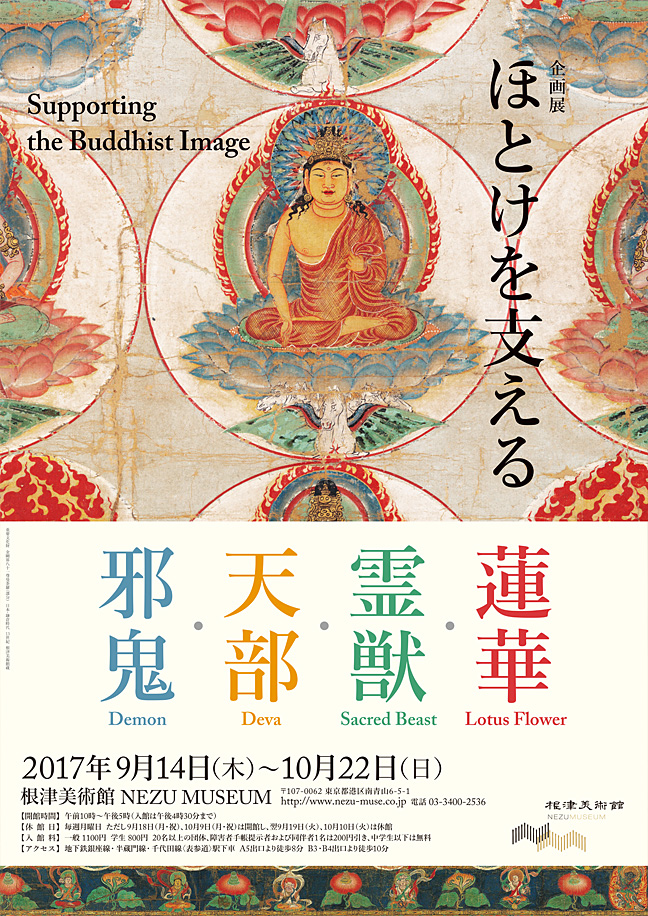

| Closed | Mondays, except 9/18 and 10/9, and closed on 9/19 and 10/10 |
|---|---|
| Hours | 10 am to 5 pm(Entrance closes 30 min. before closing) |
| General admission | Adult 1100 yen, Student 800 yen |
| Gallery | 1and 2 |
This exhibition views Buddhism’s pantheon of buddhas, bodhisattvas, and deities from a unique perspective: that of the pedestals and vehicles on which their images are presented.
The lotus flower, the symbol of Buddhism, is the most widespread type of pedestal, but by no means the only one. Monju Bosatsu (Mañjuśrī), seated on a lotus pedestal, rides on a Chinese lion, Fugen Bosatsu (Samantabhadra) on a white elephant. The armor-clad Four Guardian Kings stand on demons, and the graceful goddess Benzaiten (Sarasvatī) is seated on a lotus leaf. The world of esoteric Buddhism offers even more variations on Buddhist images and their pedestals.
A select group of __ works from the Nezu Museum collection, including the Kongōkai Mandala with Eighty-One Deities, the Legends of Zenkōji Temple, and the Aizen-myōō (Ragaraja) (all Important Cultural Properties) compose an unparalleled opportunity to examine the symbolism of Buddhist art and its stylistic riches.
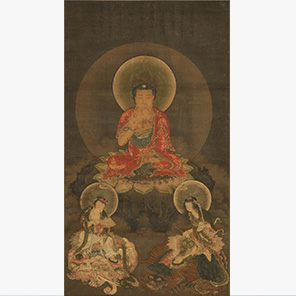

- Shaka (Shakyamuni) Triad
- Hanging scroll; ink and color on silk
Japan Nanbokuchō period, 14th century
Nezu Museum - The lotus flower is the fundamental type of seat supporting Buddhist deities. Commonly, the petals are rising around a large receptacle at the center of flower. In this example, however, the pedestal underneath Shaka, the historical Buddha, is distinguished by the depiction of the inner surfaces of the petals in full bloom, with full-bodied stamens. Monju Bosatsu sits on a Chinese lion, Fugen Bosatu is paired with a white elephant, and both animals are lying on the ground.
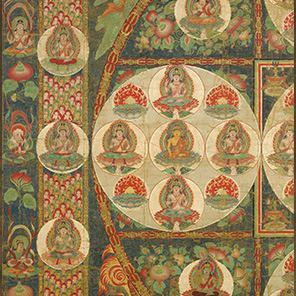


- Kongōkai Mandala with Eighty-One Deities [Detail]
- Hanging scroll; ink and color on silk
Japan Kamakura period, 13th century
Nezu Museum - The deities that comprise the Kongōkai or Diamond Realm are seated on lotus pedestals and arranged within a white moon disc, as seen in this excellent mandala. In addition, a hallmark of this mandala is that each of those pedestals is supported by a bird or beast: a peacock, elephant, or horse, for example. Their expressions, depicted in great detail, deserve a careful look.
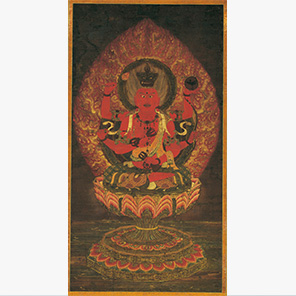


- Aizen-myōō (Ragaraja)
- Hanging scroll; ink and color on silk
Japan Kamakura period, 13th century
Nezu Museum - Aizen-myōō, an esoteric Buddhist deity, is usually presented as red-skinned and ferociously raging, seated in a red sun disc set above a sacred vase. In this painting, however, the deity is seated on a splendid polygonal platform. It is invaluable as a painting reproducing a sculpture that had been installed in Hosshōji, a temple founded by order of Emperor Shirakawa.
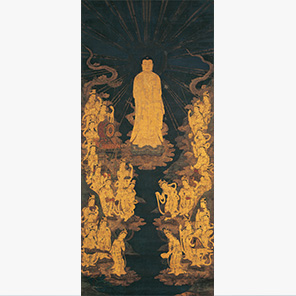

- Descent of Amida (Amitabha) and Twenty-Five Bodhisattvas
- Hanging scroll; ink and color on silk
Japan Kamakura period, 14th century
Nezu Museum - Amida is standing on a lotus pedestal on a cloud; also situated on clouds, to his left and right, are bodhisattvas playing musical instruments and dancing as they welcome the dead to the Pure Land. The trails of the clouds indicate the direction and speed of their flight.










